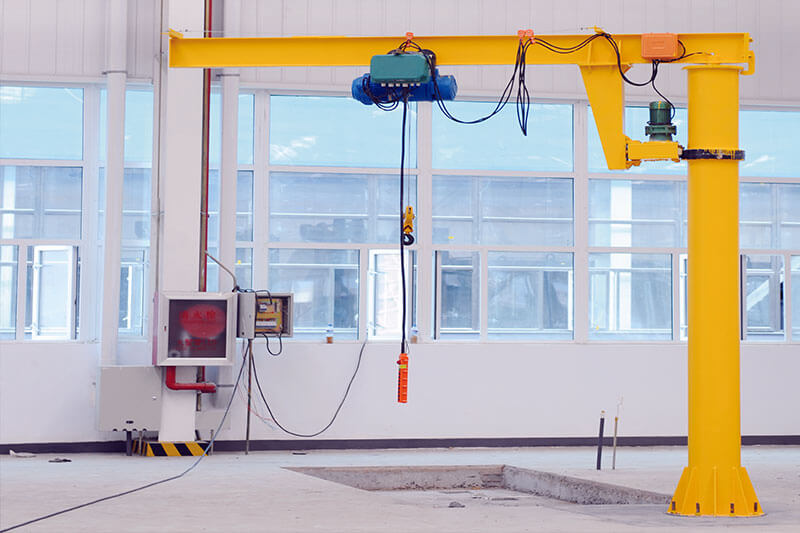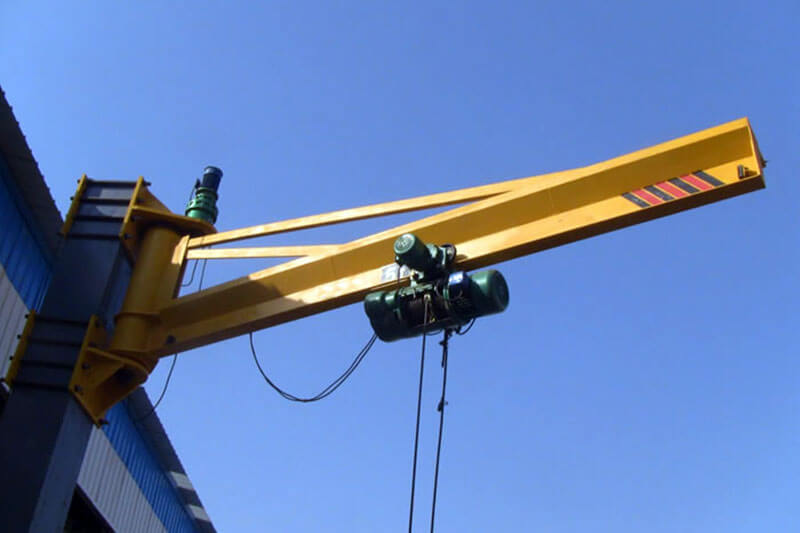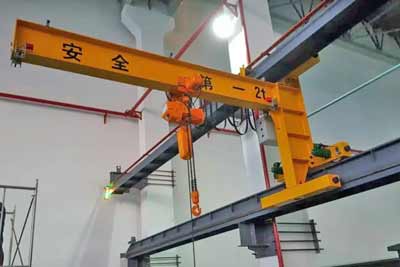Overhead Cranes in Bénin: A Blueprint for Industrial Excellence
Overhead Crane Mastery in Bénin: A Blueprint for Industrial Excellence
Overhead crane for sale sale Benin
Overhead cranes are indispensable pieces of equipment across multiple industries in Bénin, facilitating the movement of heavy loads with precision and efficiency. In this chapter, we will dive into the fundamentals of overhead cranes, offering insights into their components, functionality, and the factors you should consider when selecting the right one for your specific needs.
Types of Overhead Cranes
Overhead cranes come in various types, each designed to meet specific material handling requirements. Here are some common types you might encounter in Bénin:
- 1. Bridge Cranes: These are the most prevalent type and are commonly used in manufacturing, construction, and warehousing. Bridge cranes move along elevated runways and can lift and transport heavy loads.
- 2. Jib Cranes: Jib cranes are stationary and feature a horizontal boom (jib) that can rotate. They are ideal for localized material handling within a specific area, making them suitable for assembly lines and workshops.
- 3. Gantry Cranes: Gantry cranes are similar to bridge cranes but are supported by legs on the ground rather than overhead runways. They are used in construction, shipyards, and outdoor environments for versatile material handling.
- 4. Container Cranes: Bénin's port operations often rely on container cranes, such as ship-to-shore cranes and rubber-tired gantry cranes (RTGs). Ship-to-shore cranes load and unload cargo containers from ships, while RTGs handle container stacking within the port.

Double Girder Explosion-proof Overhead Crane
- Lifting Capacity:5-320T
- Span:10.5-31.5m
- Lifting Height: 6-18m

Double Trolly Electric Overhead Crane
- Lifting Capacity:5-450T
- Span:10.5-31.5m
- Lifting Height: 6-18m

Electromagnetic Double Girder Overhead Crane
- Lifting Capacity:5-450T
- Span:10.5-31.5m
- Lifting Height: 6-18m
 A-type Double Girder Gantry Crane
A-type Double Girder Gantry Crane U-type Double Girder Gantry Crane
U-type Double Girder Gantry CraneLight duty gantry cranes Bénin
Light duty portable gantry Crane Bénin, up to 10 ton. The most economical gantry crane solutions for sale, with high movibility.
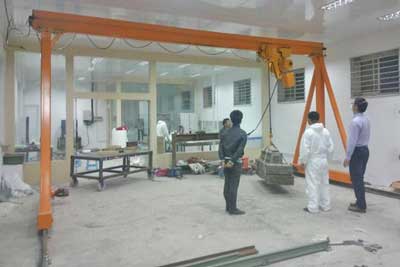 rail travelling portable gantry Crane Bénin
rail travelling portable gantry Crane Bénin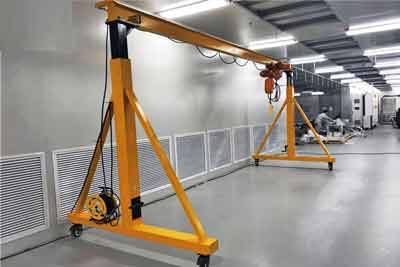 Height adjustable gantry Crane Bénin
Height adjustable gantry Crane Bénin Fixed height gantry with electric chain hoist
Fixed height gantry with electric chain hoist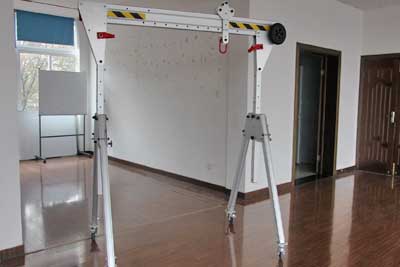 Folable gantry crane with roller travelling design
Folable gantry crane with roller travelling design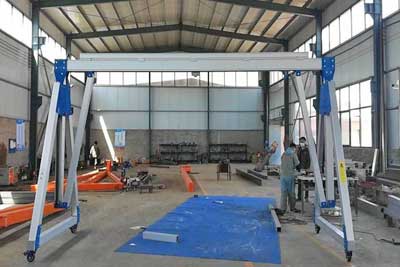 Light duty gantry Crane Bénin
Light duty gantry Crane Bénin Height adjustable gantry Crane Bénin
Height adjustable gantry Crane BéninAll Types of Jib Crane for sale Benin
Selecting the Right Overhead Crane
Choosing the right overhead crane for your specific needs is crucial. To make an informed decision, consider the following key factors:
- Load Capacity: Determine the maximum weight your crane needs to lift and transport.
- Span and Lifting Height: Evaluate the distance the crane needs to cover horizontally (span) and the maximum height it must reach (lifting height).
- Duty Cycle: Define how often and for how long the crane will be in operation each day.
- Environmental Conditions: Consider factors such as temperature, humidity, and exposure to corrosive substances that might affect crane components.
- Safety Features: Prioritize safety by selecting a crane with adequate safety features, including limit switches, emergency stop buttons, and overload protection.
Understanding these fundamentals and the types of overhead cranes available sets the stage for making an informed decision. In the following chapters, we will delve deeper into tailoring your overhead crane to meet your specific industrial sector requirements in Bénin.
Assessing Your Crane Needs
Selecting the right overhead crane for your industrial sector in Bénin begins with a thorough assessment of your specific requirements. In this chapter, we'll provide guidance on how to evaluate your crane needs, taking into account critical factors such as load capacity, span, lifting height, duty cycle, and environmental conditions. We'll also explore the importance of conducting a site evaluation to determine the ideal crane configuration.
- 1. Load Capacity: - Begin by determining the maximum weight that the crane will need to lift and transport. This is one of the most critical factors as exceeding the crane's capacity can lead to safety hazards and equipment damage.
- 2. Span and Lifting Height: - Assess the horizontal distance the crane needs to cover (span) and the maximum height it must reach (lifting height). Different industrial sectors may require varying spans and lifting heights to accommodate their specific operations.
- 3. Duty Cycle: - Consider how frequently and for how long the crane will be in operation each day. Cranes used in industries with continuous operations, such as manufacturing, may have different duty cycle requirements than those used for intermittent tasks.
- 4. Environmental Conditions: - Evaluate the environmental factors that can impact crane performance and longevity. This includes factors such as temperature, humidity, exposure to corrosive substances, and potential exposure to outdoor elements.
- 5. Load Type: - Determine the types of loads the crane will handle. Are they uniform or irregular in shape? Some industries, like agriculture and agribusiness, may deal with bulk loads, while others, like manufacturing, handle machinery or components.
- 6. Safety Requirements: - Consider your industry's safety regulations and standards. Ensure that the crane you choose complies with safety requirements, including features like limit switches, emergency stop buttons, and overload protection.
- 7. Future Expansion: - Think about your sector's growth prospects. Will your crane needs change in the future? It's essential to choose a crane that can accommodate potential expansion or changes in your operations.
Conducting a Site Evaluation:
One of the most effective ways to determine the ideal crane configuration is by conducting a thorough site evaluation. Here are some steps to follow:
- 1. Site Measurements: Measure the available workspace, including ceiling height, floor space, and any potential obstructions.
- 2. Workflow Analysis: Examine the flow of materials and operations in your workspace. Identify where the crane will be most effective and efficient.
- 3. Access Points: Determine the locations where the crane will need to access loads. Ensure that the crane can reach these points without obstacles.
- 4. Power Supply: Assess the availability and capacity of the power supply in your facility. Overhead cranes require a reliable source of electricity.
- 5. Environmental Considerations: Take note of environmental factors such as temperature, humidity, and potential exposure to chemicals or corrosive substances.
By conducting a site evaluation and carefully considering your sector's unique requirements, you can gather valuable insights to guide your overhead crane selection process. In the next chapters, we will explore customization options and connect you with reputable suppliers in Bénin who can help meet your specific crane needs.
Customized Crane Specifications
When it comes to overhead cranes in Bénin, one size doesn't fit all. That's where customization comes into play. In this chapter, we'll explore the advantages of customized overhead cranes, emphasize the importance of collaborating with experienced crane manufacturers and suppliers, and provide examples of customization options to help you tailor your crane solution to your precise requirements.
Benefits of Customized Overhead Cranes:
- 1. Optimized Performance: Customization allows you to design a crane that perfectly matches your industrial sector's needs, ensuring optimal performance and efficiency.
- 2. Enhanced Safety: Customized safety features, such as overload protection systems and anti-collision devices, can be integrated to minimize risks and improve workplace safety.
- 3. Increased Productivity: Tailoring the crane to your workflow can streamline material handling processes, resulting in higher productivity and faster project completion.
- 4. Cost Efficiency: While customized cranes may have a higher initial cost, they can offer long-term cost savings by reducing downtime, maintenance, and operational inefficiencies.
Collaborating with Experienced Manufacturers and Suppliers:
Selecting an experienced crane manufacturer or supplier in Bénin is essential for achieving successful customization. Here's why:
- 1. Technical Expertise: Experienced providers possess in-depth knowledge of crane design, engineering, and manufacturing processes, ensuring that your customized crane meets industry standards and regulations.
- 2. Problem-Solving Skills: They can offer innovative solutions to address unique challenges specific to your industrial sector.
- 3. Local Knowledge: Local manufacturers and suppliers understand Bénin's regulatory environment, infrastructure, and market conditions, allowing them to provide tailored recommendations.
- 4. Support and Maintenance: Established providers offer ongoing technical support and maintenance services to keep your crane in optimal condition.
Examples of Customization Options:
- 1. Hoist Type: Choose from various hoist types, such as electric wire rope hoists, chain hoists, or pneumatic hoists, depending on your load requirements and operational preferences.
- 2. Controls: Select the control system that suits your operations, whether it's a traditional pendant control, radio remote control, or advanced PLC-based control with automation capabilities.
- 3. Load Handling Attachments: Customize the crane with specialized attachments such as hooks, magnets, grabs, or spreader bars, depending on the nature of the materials you handle.
- 4. Safety Features: Enhance safety with features like emergency stop buttons, load limiters, anti-sway devices, and collision avoidance systems.
- 5. Variable Frequency Drives (VFDs): Implement VFDs to provide precise control over crane movements, reducing wear and tear and energy consumption.
- 6. Remote Monitoring and Diagnostics: Incorporate remote monitoring systems that allow you to track crane performance, conduct diagnostics, and schedule maintenance proactively.
- 7. Environmental Considerations: Customize cranes for specific environmental conditions, such as those found in the food industry, by using corrosion-resistant materials or special coatings.
- 8. Capacity and Span: Tailor the crane's load capacity and span to match your precise lifting requirements.
Customization empowers you to design a crane that not only meets your immediate needs but also adapts to your future growth and changing operational demands. In the next chapters, we'll guide you through sourcing reputable manufacturers and suppliers in Bénin, ensuring that your customized crane becomes a reality.
Efficiency in Elevation: Navigating Overhead Cranes for Bénin Industries
Construction Industry
Overview of Construction in Benin: The construction industry in Bénin is vital for infrastructure development and building projects. It encompasses various types of construction, including residential, commercial, and civil engineering projects.
Type of Overhead Crane Used in Construction: Bridge cranes, also known as overhead bridge cranes or gantry cranes, are commonly used in the construction industry in Bénin. These cranes are typically designed to handle heavy loads and can move materials horizontally along the overhead rail system.
Crane Functions and Applications in Construction: Bridge cranes play a crucial role in construction projects by lifting and moving heavy building materials and equipment. They are used for tasks such as:
- 1. Steel Beam Installation: Bridge cranes are essential for positioning steel beams and girders during the construction of buildings and bridges.
- 2. Concrete Block Handling: Overhead cranes help transport and place concrete blocks and precast elements precisely.
- 3. Equipment Installation: Construction equipment, including generators, HVAC systems, and large machinery, can be efficiently positioned using bridge cranes.
- 4. Material Transportation: Bridge cranes aid in the transportation of construction materials across the construction site, improving efficiency and reducing manual labor.
- 5. Assembly Line Operations: In some cases, construction projects may require assembly line operations for modular construction. Overhead cranes assist in moving components into place.
Manufacturing Industry
Overview of Manufacturing in Benin: The manufacturing sector in Bénin includes food processing, textiles, and other industries that produce a wide range of consumer goods.
Type of Overhead Crane Used in Manufacturing: Jib cranes and bridge cranes are commonly used in manufacturing facilities in Bénin. Jib cranes are suitable for smaller work areas, while bridge cranes are used for larger-scale operations.
Crane Functions and Applications in Manufacturing: Overhead cranes are employed for material handling and assembly line operations, including:
- 1. Material Loading and Unloading: Overhead cranes are used to load and unload raw materials and finished products from trucks and storage areas.
- 2. Assembly Line Feeding: They assist in feeding materials and components to assembly lines, improving production efficiency.
- 3. Equipment Maintenance: Overhead cranes are used to lift and move heavy machinery and equipment for maintenance and repair.
- 4. Storage and Inventory Management: Bridge cranes can help with efficient storage and retrieval of materials and products within manufacturing facilities.
- 5. Textile Industry: In textile manufacturing, overhead cranes help with the handling of large rolls of fabric and other textile materials.
Port and Shipping
Overview of Port and Shipping in Benin: The port of Cotonou is one of the major seaports in West Africa and serves as a crucial gateway for international trade in the region.
Type of Overhead Crane Used in Port and Shipping: Ports like Cotonou typically employ container cranes, which can be either ship-to-shore cranes or rubber-tired gantry cranes (RTGs). Ship-to-shore cranes are used for loading and unloading cargo containers from ships, while RTGs are used for container handling within the port.
Crane Functions and Applications in Port and Shipping: Overhead container cranes are essential for efficient cargo handling operations and include:
- 1. Container Loading and Unloading: Ship-to-shore cranes are positioned on docks and are used to lift containers on and off vessels. This process is crucial for international trade, as it ensures the timely movement of goods.
- 2. Container Stacking: Rubber-tired gantry cranes (RTGs) are used to stack containers in the port's storage yard, optimizing space and accessibility.
- 3. Cargo Transfer: Overhead cranes facilitate the transfer of containers between trucks and rail cars for further transportation.
- 4. Container Maintenance: Cranes are also used to position containers for maintenance and inspection.
Mining Industry
Overview of Mining in Benin: While mining is not as prominent in Bénin as in some other African countries, there may be mining operations for mineral resources like limestone, marble, and clay.
Type of Overhead Crane Used in Mining: Overhead bridge cranes with heavy lifting capacities are typically used in the mining industry to handle materials such as ore and mining equipment.
Crane Functions and Applications in Mining: Overhead cranes in mining operations perform tasks such as:
- 1. Ore Extraction: Overhead cranes are used in open-pit and underground mining to lift and transport extracted ore to processing facilities.
- 2. Equipment Handling: Heavy mining equipment, such as drills and crushers, can be moved and positioned using overhead cranes.
- 3. Maintenance Support: Cranes assist in positioning equipment for maintenance and repair.
- 4. Material Stockpiling: Overhead cranes are used to stack and store materials in designated areas.
Agriculture and Agribusiness
Overview of Agriculture and Agribusiness in Benin: Agriculture plays a significant role in Bénin's economy, with a focus on crops like cotton, maize, and palm oil.
Type of Overhead Crane Used in Agriculture: Overhead cranes used in agriculture and agribusiness may include bridge cranes or jib cranes for material handling within processing facilities.
Crane Functions and Applications in Agriculture: Overhead cranes are used for:
- 1. Bulk Material Handling: Cranes assist in moving large quantities of agricultural products, such as sacks of grain or bales of cotton, within processing plants.
- 2. Equipment Maintenance: They help position and support equipment used in agricultural processing.
- 3. Storage Operations: Overhead cranes may be used for efficient storage and retrieval of agricultural products in warehouses.
These cranes contribute to the efficiency of agricultural processes, ensuring timely processing and distribution of agricultural goods.
Energy and Infrastructure
Overview of Energy and Infrastructure in Benin: Bénin may have ongoing infrastructure development and energy projects to improve its infrastructure and energy supply.
Type of Overhead Crane Used in Energy and Infrastructure: Overhead bridge cranes are commonly used for tasks related to infrastructure and energy projects.
Crane Functions and Applications in Energy and Infrastructure: Overhead cranes are employed for tasks such as:
- 1. Erecting Transmission Towers: Cranes are used to lift and position transmission towers and power line components.
- 2. Handling Construction Materials: Overhead cranes assist in moving heavy construction materials like steel beams and concrete.
- 3. Infrastructure Maintenance: They support the maintenance and repair of infrastructure components, such as bridges and roads.
- 4. Equipment Installation: Cranes help position heavy equipment and machinery used in energy and infrastructure projects.
Manufacturing of Consumer Goods
Overview of Consumer Goods Manufacturing in Benin: Industries involved in the production of consumer goods, including furniture, electronics, and automotive components, may utilize overhead cranes.
Type of Overhead Crane Used in Consumer Goods Manufacturing: Jib cranes and bridge cranes are common choices for material handling in consumer goods manufacturing.
Crane Functions and Applications in Consumer Goods Manufacturing: Overhead cranes are used for:
- 1. Material Handling: Cranes assist in moving raw materials, components, and finished products within manufacturing facilities.
- 2. Assembly Line Support: They help position components during the assembly process, improving production efficiency.
- 3. Equipment Maintenance: Cranes are used to lift and move heavy machinery for maintenance and repair.
- 4. Storage and Inventory Management: Bridge cranes may be employed for efficient storage and retrieval of goods within manufacturing plants.
Warehousing and Logistics
Overview of Warehousing and Logistics in Benin: Warehouses and logistics centers in Bénin play a crucial role in storing and distributing goods.
Type of Overhead Crane Used in Warehousing and Logistics: Bridge cranes and stacker cranes are commonly used in warehousing and logistics for efficient material handling and storage.
Crane Functions and Applications in Warehousing and Logistics: Overhead cranes contribute to the efficiency of warehousing and logistics operations by:
- 1. Material Handling: Cranes assist in loading and unloading goods from trucks and organizing them within the warehouse.
- 2. Pallet Handling: They facilitate the movement of palletized goods to and from storage areas.
- 3. High-Density Storage: Stacker cranes are used for automated, high-density storage solutions, optimizing space utilization.
- 4. Inventory Management: Overhead cranes help manage and retrieve goods from storage shelves quickly.
In the warehousing and logistics sector, the use of overhead cranes is essential for streamlining supply chain operations and ensuring efficient storage and retrieval of goods.
Sourcing Overhead Cranes in Bénin
Now that we've explored the importance of customization and the benefits it offers, it's time to navigate the process of sourcing your overhead crane in Bénin. In this chapter, we'll list and describe reputable crane manufacturers, suppliers, and distributors operating in Bénin. We'll also emphasize the significance of conducting due diligence when choosing a supplier and offer practical tips for negotiating pricing and terms.
Conducting Due Diligence:
Choosing the right crane supplier is a critical decision that can impact your crane's performance, safety, and longevity. Here's how to conduct due diligence:
- 1. Verify Reputation: Research the supplier's reputation by checking customer reviews, asking for references, and inquiring within your industry network.
- 2. Experience and Expertise: Evaluate the supplier's experience in customizing overhead cranes for your industrial sector. Ask about their previous projects and success stories.
- 3. Compliance and Certification: Ensure the supplier complies with relevant industry standards and certifications. This includes safety regulations and quality control measures.
- 4. Technical Support: Inquire about the supplier's technical support and maintenance services. A reliable supplier should offer ongoing assistance to keep your crane in optimal condition.
Negotiating Pricing and Terms:
When negotiating with a crane supplier, consider these tips to secure a favorable deal:
- 1. Request Multiple Quotes: Obtain quotes from different suppliers to compare pricing and services. This helps you gauge the market and identify competitive offers.
- 2. Clarify Terms and Warranties: Clearly understand the terms of the contract, including warranties, delivery timelines, and payment schedules. Address any ambiguities before finalizing the agreement.
- 3. Negotiate for Customization: If your project requires specific customizations, negotiate these requirements early in the process to ensure they are accommodated within the budget.
- 4. Consider Long-Term Value: Don't solely focus on the initial purchase cost. Consider the long-term value, including maintenance and operational costs, when evaluating pricing.
- 5. Payment Flexibility: Negotiate payment terms that align with your project's cash flow. Some suppliers may offer installment options or financing arrangements.
By carefully selecting a reputable supplier, conducting due diligence, and negotiating pricing and terms, you can ensure a successful acquisition of your customized overhead crane in Bénin. In the following chapters, we will explore regulatory and safety considerations, as well as installation and maintenance support to keep your crane operating efficiently and safely.
Regulatory and Safety Considerations
Ensuring the safety and compliance of your overhead crane in Bénin is paramount. In this chapter, we will delve into the regulatory and safety standards applicable to overhead cranes in the country, provide insights into certifications, inspections, and compliance requirements, and emphasize the critical importance of maintaining and operating overhead cranes safely.
Regulatory and Safety Standards:
Bénin, like many countries, adheres to international and national standards to regulate overhead crane operations. The following standards and regulations are essential to understand:
- 1. ISO Standards: The International Organization for Standardization (ISO) provides guidelines for crane design, manufacturing, and safety. ISO 4301, ISO 20332, and ISO 12482 are among the relevant standards.
- 2. National Regulations: Bénin may have specific national regulations governing overhead crane operations, including safety protocols, load limits, and inspection requirements. It is essential to consult local authorities and regulatory bodies for the most up-to-date information.
Certifications, Inspections, and Compliance Requirements:
- 1. CE Marking: If your overhead crane is sourced from Europe or meets European standards, it may carry the CE marking, indicating compliance with European Union safety regulations.
- 2. Load Testing: Overhead cranes should undergo load testing to verify their safe lifting capacity. Certification for load testing is crucial to ensure safe operation.
- 3. Routine Inspections: Regular inspections are necessary to identify and address wear and tear, damaged components, or potential hazards. Inspections should be conducted by trained personnel and documented.
- 4. Operator Training: Crane operators should receive proper training and certification to operate overhead cranes safely. Training programs should cover crane operation, load handling, and safety protocols.
- 5. Safety Devices: Ensure your overhead crane is equipped with essential safety devices, including limit switches, emergency stop buttons, overload protection systems, and anti-collision mechanisms.
Maintaining and Operating Overhead Cranes Safely:
- 1. Regular Maintenance: Establish a routine maintenance schedule to keep your crane in optimal condition. This includes lubrication, component checks, and addressing any issues promptly.
- 2. Safety Procedures: Implement comprehensive safety procedures for crane operations, including load handling, communication between operators and ground personnel, and emergency response plans.
- 3. Load Limits: Never exceed the crane's specified load limits. Overloading can lead to structural damage, accidents, and injuries.
- 4. Safety Training: Continuously train and educate crane operators and maintenance personnel on safety protocols and best practices.
- 5. Reporting and Documentation: Maintain thorough records of inspections, maintenance, and any incidents or accidents. Proper documentation helps track crane performance and safety history.
- 6. Emergency Response: Develop and communicate clear procedures for responding to emergencies or malfunctions during crane operations.
Compliance with regulatory standards and a strong commitment to safety are essential for successful overhead crane operation in Bénin. Neglecting safety protocols can lead to accidents, damage, and legal liabilities. In the subsequent chapters, we will explore installation, maintenance, and support services to ensure that your crane operates efficiently and safely throughout its lifespan.
Installation, Maintenance, and Support
Now that you've selected the right overhead crane for your industrial needs in Bénin, it's crucial to understand the installation process, the importance of routine maintenance, and the availability of technical support and spare parts. This chapter will guide you through these critical aspects to ensure your crane operates efficiently and safely.
Installation Process:
The installation of an overhead crane is a complex and precise process that involves several key steps:
- Site Preparation: Ensure that the installation site is prepared according to the crane manufacturer's specifications. This includes the foundation, runway beams, and supporting structures.
- Assembly: Skilled professionals will assemble the crane components, including the bridge, trolley, hoist, and runway beams. This process demands precision to ensure proper alignment and functionality.
- Electrical Setup: Wiring, controls, and electrical components are installed and connected according to design specifications.
- Load Testing: After assembly and electrical setup, load testing is performed to verify that the crane operates safely and efficiently under its specified load capacity.
- Calibration: Fine-tuning the crane's controls and safety systems to ensure smooth operation and compliance with safety standards.
Professional installation is critical to avoid safety risks and ensure that your crane operates as designed.
Routine Maintenance and Servicing:
Routine maintenance is essential to keep your overhead crane in optimal working condition. Here are key maintenance activities:
- Lubrication: Regularly lubricate moving parts to reduce friction and wear.
- Component Inspection: Periodically inspect all crane components, such as hooks, ropes, cables, and electrical systems, for signs of wear, damage, or corrosion.
- Safety Checks: Ensure that safety features, including limit switches, emergency stop buttons, and overload protection systems, are functioning correctly.
- Alignment and Calibration: Check and recalibrate the crane's controls and systems as needed.
- Documentation: Maintain detailed records of maintenance activities, inspections, and any repairs or replacements. This documentation is valuable for tracking crane performance and compliance.
Technical Support and Spare Parts:
Reliable technical support and access to spare parts are crucial for addressing any issues or breakdowns promptly. Ensure that you have access to:
- Local Service Providers: Identify local companies or technicians with expertise in overhead crane maintenance and repair.
- Technical Hotline: Contact the crane manufacturer or supplier for technical support and guidance on troubleshooting issues.
- Spare Parts Inventory: Ensure that spare parts for your specific crane model are readily available in Bénin. Having a stock of critical spare parts on-site can reduce downtime in case of breakdowns.
- Scheduled Servicing: Consider arranging for scheduled maintenance and servicing contracts with local providers to ensure regular check-ups and repairs.
By prioritizing professional installation, routine maintenance, and access to technical support and spare parts, you can maximize the lifespan and efficiency of your overhead crane in Bénin. In the following chapters, we will explore considerations for budgeting and financing your crane investment, as well as real-world case studies highlighting the impact of customized overhead cranes in various industrial sectors.
Budgeting and Financing
Investing in an overhead crane for your industrial operations in Bénin is a significant decision that requires careful budgeting and consideration of financing options. In this chapter, we'll provide guidance on budgeting for the purchase of an overhead crane, including factors to consider for long-term return on investment (ROI). We'll also discuss financing options, grants, or incentives that may be available in Bénin to support crane investments.
Budgeting for an Overhead Crane:
- 1. Initial Cost: Consider the upfront cost of purchasing and installing the overhead crane. This includes the crane itself, installation expenses, and any modifications needed to your facility.
- 2. Customization Costs: If you're customizing the crane to meet specific requirements, factor in the additional costs associated with these modifications.
- 3. Operational Costs: Estimate ongoing operational costs, including electricity, maintenance, and replacement parts. Ensure that you have a maintenance budget in place to keep the crane in optimal condition.
- 4. Training Expenses: Budget for operator training programs to ensure safe and efficient crane operation.
- 5. Insurance: Consider insurance costs to protect your investment and mitigate potential liabilities.
Long-Term Return on Investment (ROI):
While it's essential to manage your overhead crane budget, it's equally crucial to consider the long-term ROI:
- 1. Increased Productivity: A well-chosen overhead crane can significantly improve productivity, potentially leading to higher revenues over time.
- 2. Reduced Downtime: Minimizing downtime due to breakdowns or inefficient material handling can result in cost savings and increased production.
- 3. Safety Improvements: A safer work environment can reduce workplace accidents and associated costs while enhancing employee morale and retention.
- 4. Energy Efficiency: Some modern cranes are designed for energy efficiency, which can lead to lower electricity costs in the long run.
Financing Options and Incentives:
In Bénin, there may be financing options, grants, or incentives available to support your overhead crane investment:
- 1. Government Grants: Research whether the Bénin government or regional authorities offer grants or subsidies for industrial equipment purchases. These programs can significantly reduce your initial costs.
- 2. Financial Institutions: Contact local banks or financial institutions to explore loan options or equipment financing tailored to crane investments.
- 3. Leasing: Consider leasing an overhead crane instead of an outright purchase. Leasing can spread the cost over time and may include maintenance services.
- 4. Tax Incentives: Inquire about potential tax incentives or deductions that may apply to capital investments in industrial equipment, including overhead cranes.
- 5. Industry Associations: Consult industry associations or trade groups that may offer financing support or information on available incentives.
- 6. International Aid and Development Programs: In some cases, international aid organizations may offer assistance for infrastructure and industrial development projects in Bénin.
By carefully budgeting for your overhead crane investment and exploring available financing options and incentives, you can make a financially sound decision that aligns with your long-term business goals. In the next chapter, we will showcase real-world case studies highlighting the impact of customized overhead cranes in various industrial sectors in Bénin, providing practical examples of successful crane investments.
Frequently Asked Questions (FAQs)
Here are some common questions and answers related to overhead cranes and their purchase in Bénin:
1. What is an overhead crane?
- An overhead crane, also known as a bridge crane, is a mechanical lifting device used to move heavy loads horizontally and vertically within industrial settings. It consists of a bridge, hoist, trolley, and runway beams.
2. Why are overhead cranes important in Bénin?
- Overhead cranes play a crucial role in various industrial sectors in Bénin, facilitating the efficient handling of heavy materials, improving productivity, and enhancing safety.
3. How do I choose the right overhead crane for my needs?
- Selecting the right overhead crane involves assessing factors such as load capacity, span, lifting height, duty cycle, environmental conditions, and safety requirements. Conducting a site evaluation is also crucial.
4. What are the benefits of customizing an overhead crane?
- Customization allows you to tailor the crane to your specific industrial sector's requirements, optimizing performance, safety, and productivity.
5. How can I find reputable crane manufacturers and suppliers in Bénin?
- You can research local manufacturers and suppliers, ask for referrals within your industry network, or consult directories and online resources to identify reputable providers.
6. What safety standards should I be aware of when using overhead cranes in Bénin?
- Overhead crane operations in Bénin should comply with international standards like ISO 4301 and relevant national regulations. Safety features and regular inspections are essential.
7. How often should I perform maintenance on my overhead crane?
- Routine maintenance should be scheduled based on the crane's usage and manufacturer recommendations. Regular inspections and lubrication are critical to crane longevity.
8. Are there financing options available for purchasing overhead cranes in Bénin?
- Yes, you can explore financing options through local banks, leasing companies, government grants, or international aid and development programs.
9. What role does operator training play in overhead crane safety?
- Proper operator training is essential for safe and efficient crane operation. Training programs cover crane controls, load handling, safety protocols, and emergency procedures.
10. Can I retrofit an existing overhead crane for better performance?
- In many cases, retrofitting existing overhead cranes with modern components, controls, and safety features can improve their performance and extend their lifespan.
These FAQs provide valuable insights into overhead crane selection, operation, and investment in Bénin. If you have more specific questions or require detailed information, consult with crane experts or suppliers in your area.
Conclusion
In this comprehensive guide, we've embarked on a journey to help you make informed decisions when purchasing overhead cranes for your industrial operations in Bénin. Let's recap the key takeaways and encourage you to approach this investment with confidence and preparedness.
Key Takeaways:
- Customization is Key: Overhead cranes can be tailored to meet the unique requirements of your industrial sector in Bénin, optimizing performance, safety, and productivity.
- Safety is Paramount: Compliance with safety standards and regulations, routine maintenance, and operator training are essential to ensure safe crane operations.
- Budget Wisely: Carefully budget for your overhead crane investment, considering initial costs, long-term ROI, and financing options.
- Due Diligence: Choose reputable crane manufacturers and suppliers, conduct thorough research, and negotiate pricing and terms wisely.
- Technical Support: Ensure you have access to technical support, spare parts, and maintenance services to keep your crane operating efficiently.
- Stay Informed: Continue learning about the latest advancements in overhead crane technology and safety practices to maintain your competitive edge.
Selecting the right overhead crane for your specific industrial sector is a critical decision that can significantly impact your operations. By assessing your needs, customizing your crane, complying with safety regulations, and carefully managing your budget, you can make a choice that enhances your efficiency, productivity, and safety.
We encourage you to reach out to local crane experts, manufacturers, and suppliers in Bénin for further guidance and assistance in your overhead crane acquisition journey. They can provide tailored solutions, answer specific questions, and offer valuable insights based on their expertise and experience.
Thank you for choosing this guide as your resource for overhead crane procurement in Bénin. We wish you success in finding the perfect crane solution that aligns with your industrial sector's needs and fuels your growth and productivity. For additional inquiries or assistance, please feel free to contact your crane manufacturer and supplier.












